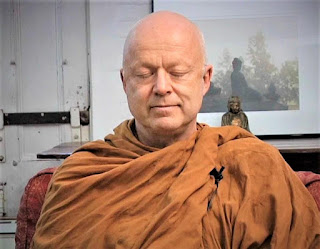Willing to Learn in Meditations ~ Dhamma Talks by Ṭhānissaro Bhikkhu
Toward the end of his life, Ajaan Maha Boowa was recorded as saying that Ajaan Lee was Ajaan Mun’s favorite student. When you look at Ajaan Lee’s life, you can see why. He was the kind of person who would listen and think in addition to meditating. That’s how he wrote all those books. And he was constantly interested in new things. Ajaan Fuang once told me that he thought it was a shame that Ajaan Lee hadn’t met me. Here I was, someone with a Western education, and Ajaan Lee would have really picked my brain. He was always interested in learning.
When he was abbot of the monastery in Chanthaburi, a new magazine, Dhammacaksu, had come out. The monks in Bangkok were in the process of translating the Pali Canon into Thai, and they published a magazine of articles along with some new sutta translations as they were being produced. Ajaan Lee was a subscriber. Once a month, the magazine would come, and for the next couple of nights Ajaan Lee would simply read the magazine out loud during the group meditation.
So it’s not the case that you learn a few basic concepts and then forget about the books and just meditate, or that you just do as you’re told. You have to think some things through. Then, as you meditate, you’ve got to think through the results of what you’ve done and try to make sense of where you are, what you’ve learned.
This may have been another characteristic that Ajaan Mun liked about Ajaan Lee. On the one hand, Ajaan Mun would give Ajaan Lee a really difficult assignment—like sitting up all night many nights in a row—and Ajaan Lee would simply do it. On the other hand, though, he noticed that Ajaan Lee also had a mind that liked to put things together to make sense out of them. As he told Ajaan Lee, he didn’t see anybody else who could help put the different principles of the practice into order.
That’s what we see in Ajaan Lee’s books, what they call ‘lak wichaa’ in Thai: the principles of knowledge or the principles of skill. They require that you have that kind of quality: First, you listen. Second, you try to put things together, to make sense out of them. And then third, you actually try to take what you’ve learned, put it into practice, and be very honest with yourself about the results that are actually developing.
Then take those results and think about them again: Where are they still good? Where are they lacking?
This is how we put all those three aspects of discernment together: listening, thinking, and developing. Ajaan Lee explains how we do this with analogies of developing skills. He says you learn from the teacher, say, how to weave a basket or how to sew a pair of pants, how to make clay tiles. Then you think about it, and then you do it, and then you think about it again. You look at the example from the teacher and you look at your product: Where is yours still lacking?
What does it look like you did wrong? Then you work at it again, and keep observing.
Eventually, as you keep this up, you can go beyond what you simply learned from the teacher and you start thinking of new ways of using that skill.
When you meditate, you learn the instructions on how to breathe, how to work with the breath.
Then you try them out and look at what you’ve got. If the results aren’t good, go back and look at what you’re doing again. Think about it. What’s still missing? Try to be observant. Look around. Ask questions if you can’t figure things out—and don’t be afraid to ask questions.
*******
From Willing to Learn in Meditations 10: Dhamma Talks by Ṭhānissaro Bhikkhu
https://www.dhammatalks.org/books/Meditations10/Section0048.html


No comments:
Post a Comment